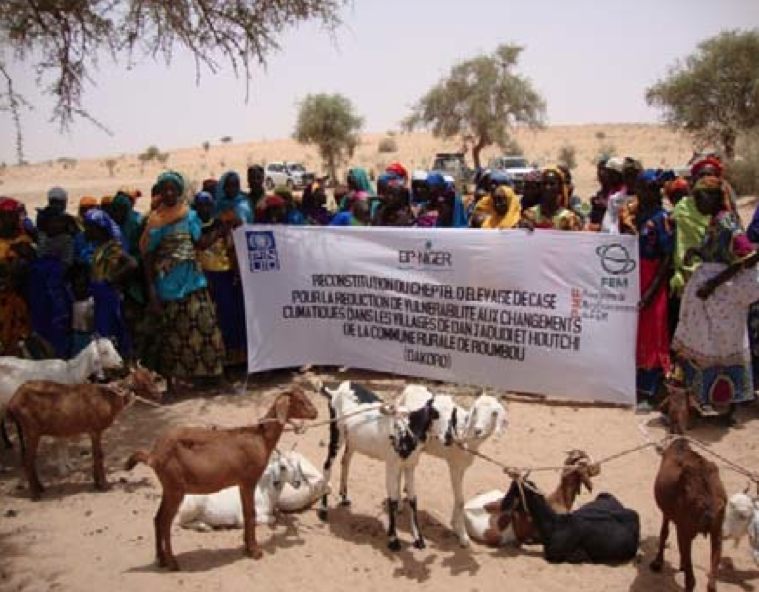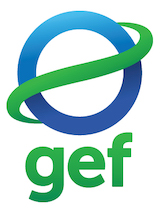CBA Niger: Hut Livestock to Reduce Household Vulnerability in Houtchi and Dan Djaoudi, Roumbou (EIP)
Project Overview
Houtchi and Dan Djaoudi villages in Niger’s Roumbou municipality, Tarka Valley, have a population of approximately 1,831 people. The main economic activities are rain-fed agriculture, including wheat and sorghum, and livestock breeding. The adverse impacts of climate change in the region are leading to water scarcity, drought, soil degradation, decrease in fodder production, death of livestock and decreases in agricultural yield. As a result, the population now relies heavily on the exploitation of their natural resources, such as the commercialization of firewood, for their livelihoods.
The Community-Based Adaptation project aims to protect the Tarka ecosystem by providing surrounding communities with livelihood alternatives to lessen their exploitation of natural resources. The project supports the provision of livestock to vulnerable households to increase their food security and to provide alternative sources of income. It was formulated and is being implemented through a participatory process carried out by the project's NGO partner, EIP, and involving a variety of stakeholders.
* This project is part of Niger's Community-Based Adaptation portfolio. *
Project Details
This Community-Based Adaptation project takes place in Houtchi and Dan Djaoudi villages in the municipality of Roumbou, Niger. The communities comprise 1,831 people, and make up 305 households. The main economic activities are rainfed agriculture, including wheat and sorghum, and livestock breeding.
These activities are primarily carried out by women to complement products coming from other agricultural crops such as gumbo, pepper, cotton. The adverse impacts of climate change in the region are leading to water scarcity, drought, soil degradation, decrease in fodder production, death of livestock and decreases in agricultural yield. As a result, the population now relies heavily on the exploitation of their natural resources, such as the commercialization of firewood, for their livelihoods.
This CBA project aims at protecting the Tarka ecosystem by providing the surrounding communities with livelihood alternatives other than the exploitation of natural resources. It supports the provision of livestock to vulnerable households to increase their food security and provide alternative sources of income. This will help decrease pressures on Tarka’s natural resources of Tarka.
Specifically, the project implements an awareness-raising campaign to increase community recognition of climate change risks and adaptation strategies. A focus on women will result in the creation of women’s cooperatives and a women’s federation. Women’s livelihoods will then be improve through the allocation of genetically improved goats as a source of income. These beneficiaries will also be trained in livestock management. Finally a trip to study and share experiences will round ensure the longevity and spread of the project’s successes.
This UNDP/GEF CBA project was formulated through a participatory process carried out by the NGO EIP and involving a variety of stakeholders. It will be implemented through a participatory and community approach, taking into consideration the daily concerns of the population. Strategies implemented for reducing the adverse impacts of climate change will be discussed and evaluated based on their efficacy.
Key Results and Outputs
- Raise awareness of climate change risks and adaptation strategies
- Create an organization of women into cooperatives and a federation
- Ameliorate womens’ livelihoods by allocating genetically improved goats to them as a source of income
- Train beneficiaries in livestock management
- Organize a trip to study and share experiences
Reports and Publications
Brochures, Posters, Communications Products
Annual Reports
Project Brief / Fact Sheet
Monitoring and Evaluation
Monitoring and evaluation for community-based adaptation is a new field, and the CBA project is piloting innovative approaches to evaluating the success of locally-driven adaptation projects, and generating lessons to inform ongoing practice.
Key considerations in M&E for CBA include:
- Grounding M&E in the local context: M&E for CBA should avoid overly rigid frameworks, recognizing community heterogeneity and maintaining local relevance
- Capturing global lessons from local projects: CBA projects are highly contextualized, but lessons generated should be relevant to stakeholders globally
- Incorporation of both quantitative and qualitative indicators: to ground projects in tangible changes that can be objectively evaluated, and to capture lessons and case studies for global dissemination
To these ends, the CBA project uses three indicator systems: the Vulnerability Reduction Assessment, the Small Grants Programme Impact Assessment System, and the UNDP Climate Change Adaptation Indicator Framework.
The Vulnerability Reduction Assessment (VRA)
The VRA is a question-based approach with the following aims:
- To make M&E responsive to community priorities
- To use M&E to make projects more accountable to local priorities
- To make M&E capture community ideas and local knowledge
- To gather community-level feedback to guide ongoing project management
- To generate qualitative information
- To capture lessons on specific issues within community-based adaptation
- To generate case studies highlighting adaptation projects
The VRA follows UNDP's Adaptation Policy Framework, and is measured in a series of meetings with local community stakeholders. In these meetings, locally-tailored questions based on standard VRA questions/indicators are posed, and the community assigns a numerical score on a 1-10 scale for each question. Progress is evaluated through changes in scores over the course of implementation, as well as through qualitative data collected in community discussions surrounding the exercise.
UNDP has developed a Users Guide to the VRA (Espanol) (Francais) as a tool to assist practitioners to conceptualize and execute VRA measurements in the context of CBA projects.
The SGP Impact Assessment System (IAS)
The CBA, being a project of the GEF Strategic Priority on Adaptation, aims to increase the resilience of ecosystems and communities to the impacts of climate change, generating global environmental benefits, and increasing their resilience in the face of climate change impacts. To this end, the CBA projects use the SGP's impact assessment system for monitoring achievements in GEF focal areas (focusing primarily on biodiversity and sustainable land management).
The IAS is composed of a number of quantitative indicators which track biophysical ecosystem indicators, as well as policy impact, capacity development and awareness-building.
UNDP Climate Change Adaptation Indicator Framework
CBA projects also track quantitative indicators from UNDP's adaptation indicator framework, corresponding to the thematic area on natural resources management. More information on UNDP's indicator framework can be found on the UNDP climate change adaptation monitoring and evaluation website.
* This description applies to all projects implemented through UNDP's Community-Based Adaptation programme. Specific details on this project's M&E will be included here as they become available. *






